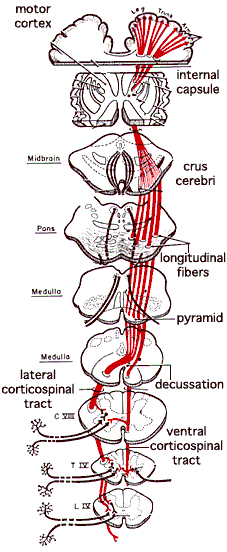The pyramidal tract originates with pyramidal neurons in the cerebral cortex. The neurons send their axons to the spinal cord (corticospinal tract) or to cranial nerve motor nuclei.
The pyramidal tract traverses internal capsule, crus cerebri, longitudinal fibers of the pons, and pyramids of the medulla oblongata (the latter being the basis for the name of the tract).
At the junction of the brain and spinal cord, most pyramidal tract fibers decussate and form the lateral corticospinal tract in the lateral funiculus. A minority of fibers continue on (ventral corticospinal tact) and decussate within the spinal cord.
After the tongue & lips, the pyramidal tract is most concerned with distal joints of the limbs. Thus it is a more significant tract to primates and raccoons than it is to common domestic mammals.
In addition to the motor area, the premotor area and the somesthetic area contribute to the pyramidal tract. And, beyond its motor function, the pyramidal tract regulates sensory pathway traffic by influencing synaptic effects of primary afferent neurons on projection neurons.
